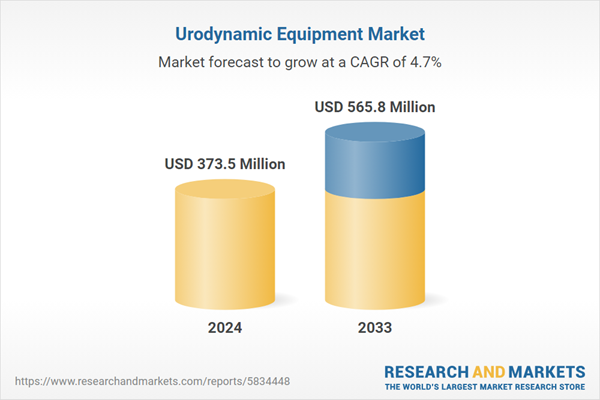Urodynamic equipment refers to a specialized medical device used to evaluate the functioning of the urinary system. It is comprised of several components, such as a catheterization kit, pressure transducer, filling pump, flow meter, and computerized data acquisition system. It is designed to measure various parameters of the bladder and the urethra, such as pressure, volume, and flow rate. Urodynamic equipment is widely used to treat urinary incontinence, voiding dysfunction, neurogenic bladder, interstitial cystitis, and prostate problems. It provides detailed, accurate, and measured information about urinary functions, which aids healthcare professionals in early disease diagnosis, making informed decisions, and selecting appropriate treatment options. Urodynamic equipment also enhances patients’ comfort, improves clinical outcomes, reduces healthcare expenditure, and minimizes the risk of complications.
Urodynamic Equipment Market Trends:
The increasing prevalence of urological disorders due to urinary tract infections (UTIs), enlarged prostates, medications, and unhealthy lifestyles is one of the primary factors providing a thrust to the market growth. Urodynamic equipment is widely used to assess urinary function, identify abnormalities, and measure bladder capacity, pressure, and flow rate to diagnose various diseases and identify underlying causes. In addition to this, the widespread equipment utilization to evaluate the effectiveness of different urinary treatments, such as surgery, medications, and pelvic exercises, is acting as another growth-inducing factor. Furthermore, the rising geriatric population with high susceptibility to urological diseases, owing to hormonal changes, weak urinary tract muscles, and chronic conditions, such as diabetes, hypertension, and cardiovascular diseases (CVDs), is providing an impetus to the market growth. Apart from this, the increasing awareness among the masses regarding early diagnosis of urinary disorders to prevent future complications, such as cancer, kidney damage, and sexual dysfunction, is propelling the market growth. Additionally, the introduction of wireless urodynamic equipment, which is portable, compact, lightweight, provides remote monitoring capabilities, and eliminates the need for patients to visit healthcare facilities regularly, is positively influencing the market growth. Besides this, the utilization of artificial intelligence (AI) to improve the accuracy of diagnoses and aid healthcare professionals in developing personalized treatment plans is favoring the market growth. Moreover, the implementation of supportive government policies to incentivize patients and provides access to high-quality treatment options are contributing to the market growth. Other factors, including rapid expansion of the healthcare industry, extensive research and development (R&D) activities, and the growing demand for minimally invasive (MI) procedures, are anticipated to drive the market growth.Key Market Segmentation:
The publisher provides an analysis of the key trends in each segment of the global urodynamic equipment market, along with forecasts at the global, regional, and country levels from 2025-2033. Our report has categorized the market based on type, application, and end user.Type Insights:
- Uroflowmetry Equipment
- Cystometry
- Ambulatory Urodynamic Systems
- Electromyographs
- Video Urodynamic Systems
- Urodynamic Consumables
Application Insights:
- Kidney Diseases
- Cancer
- Others
End User Insights:
- Hospitals
- Ambulatory Centers
- Others
Regional Insights:
- North America
- United States
- Canada
- Asia Pacific
- China
- Japan
- India
- South Korea
- Australia
- Indonesia
- Others
- Europe
- Germany
- France
- United Kingdom
- Italy
- Spain
- Russia
- Others
- Latin America
- Brazil
- Mexico
- Others
- Middle East and Africa
Competitive Landscape:
The report has also provided a comprehensive analysis of the competitive landscape in the global urodynamic equipment market. Competitive analysis such as market structure, market share by key players, player positioning, top winning strategies, competitive dashboard, and company evaluation quadrant has been covered in the report. Also, detailed profiles of all major companies have been provided. Some of the companies covered include Delta Med S.p.A., Gemini Medical Technologies, Laborie Inc., Medica SpA, Medkonsult medical technology s.r.o., Neomedix Systems Pty. Ltd., Schippers Medizintechnik, etc. Kindly note that this only represents a partial list of companies, and the complete list has been provided in the report.Key Questions Answered in This Report:
How has the global urodynamic equipment market performed so far, and how will it perform in the coming years?What are the drivers, restraints, and opportunities in the global urodynamic equipment market?
What is the impact of each driver, restraint, and opportunity on the global urodynamic equipment market?
What are the key regional markets?
Which countries represent the most attractive urodynamic equipment market?
What is the breakup of the market based on the type?
Which is the most attractive type in the urodynamic equipment market?
What is the breakup of the market based on the application?
Which is the most attractive application in the urodynamic equipment market?
What is the breakup of the market based on end user?
Which is the most attractive end user in the urodynamic equipment market?
What is the competitive structure of the global urodynamic equipment market?
Who are the key players/companies in the global urodynamic equipment market?
Table of Contents
Companies Mentioned
- Delta Med S.p.A.
- Gemini Medical Technologies
- Laborie Inc.
- Medica SpA
- Medkonsult medical technology s.r.o.
- Neomedix Systems Pty. Ltd.
- Schippers Medizintechnik
Methodology

LOADING...
Table Information
| Report Attribute | Details |
|---|---|
| No. of Pages | 131 |
| Published | January 2025 |
| Forecast Period | 2024 - 2033 |
| Estimated Market Value ( USD | $ 373.5 Million |
| Forecasted Market Value ( USD | $ 565.8 Million |
| Compound Annual Growth Rate | 4.7% |
| Regions Covered | Global |
| No. of Companies Mentioned | 7 |









